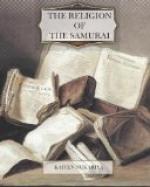[FN#286] Such a statement concerning the creation of the universe as the one here given is found in I King (Eeki-kyo). The primordial substance is not exactly ‘gas,’ but we may conceive it as being something like a nebula.
(Some)[FN#287] Buddhists, (however), maintain simply that the nearest (origin) is Karma,[FN#288] as we were born among men as the results of the Karma that we had produced in the past existences; and that the remotest (origin) is the Alaya-vijnyana,[FN#289] (because) our Karma is brought forth by illusion, and (illusion by attachment), and so forth, in one word, the Alaya is the origin of life. Although all of (these scholars) claim that they have already grasped the ultimate truth, yet not in fact.
[FN#287] Not all Buddhists, but some of them, are meant here-that is, Hinayanists and Dharma-laksanists.
[FN#288] According to Hinayanists, Karma (action) is that moral germ which survives death and continues in transmigration. It may be conceived as something like an energy, by the influence of which beings undergo metempsychosis.
[FN#289] According to the Dharma-laksana Sect, Alaya-vijnyana (receptacle-knowledge) is the spiritual Substance which holds the ‘seeds’ or potentialities of all things.
Confucius, Lao Tsz, and Shakya, however, were all the wisest of sages. Each of them gave his teachings in a way different from the other two, that they might meet the spiritual needs of his time and fit to the capacities of men. (So that) the Buddhist and the outside doctrines, each supplementing the other, have done good to the multitude. They were all (intended) to encourage thousands of virtuous acts by explaining the whole chain of causality. They were (also intended) to investigate thousands of things, and throw light on the beginning and on the end of their evolution. Although all these doctrines (might) answer the purpose of the sages, yet there must be some teachings that would be temporary,[FN#290] while others would be eternal. The first two faiths are merely temporary, while Buddhism includes both the temporary and the eternal. We may act according to the precepts of these three faiths, which aim at the peace and welfare (of man), in so far as they encourage thousands of virtuous acts by giving warning against evil and recommending good. (But) Buddhism (alone) is altogether perfect and best of all, in investigating thousands of things and in tracing them back to their first cause, in order to acquire thorough understanding of the natures of things and to attain to the ultimate truth.
[FN#290] The temporary doctrine means the teaching preached by Shakya Muni to meet the temporary needs of the hearers. The term is always used in contrast with the real or eternal doctrine.




